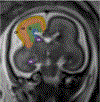Fetal Neuroimaging Updates
- PMID: 34717845
- PMCID: PMC8562558
- DOI: 10.1016/j.mric.2021.06.007
Fetal Neuroimaging Updates
Abstract
MR imaging is used in conjunction with ultrasound screening for fetal brain abnormalities because it offers better contrast, higher resolution, and has multiplanar capabilities that increase the accuracy and confidence of diagnosis. Fetal motion still severely limits the MR imaging sequences that can be acquired. We outline the current acquisition strategies for fetal brain MR imaging and discuss the near term advances that will improve its reliability. Prospective and retrospective motion correction aim to make the complement of MR neuroimaging modalities available for fetal diagnosis, improve the performance of existing modalities, and open new horizons to understanding in utero brain development.
Keywords: Fetus; Magnetic resonance imaging; Neuroimaging.
Copyright © 2021 Elsevier Inc. All rights reserved.
Conflict of interest statement
Disclosure The authors have no commercial or financial conflicts of interest to declare.
Figures















References
-
- Coblentz AC, Teixeira SR, Mirsky DM, Johnson AM, Feygin T, Victoria T. How to read a fetal magnetic resonance image 101. Pediatr Radiol. 2020;50(13):1810–1829. - PubMed
-
- AIUM-ACR-ACOG-SMFM-SRU Practice Parameter for the Performance of Standard Diagnostic Obstetric Ultrasound Examinations. J Ultrasound Med. 2018;37(11):E13–E24. - PubMed
-
- Choi JJ, Yang E, Soul JS, Jaimes C. Fetal magnetic resonance imaging: supratentorial brain malformations. Pediatr Radiol. 2020;50(13):1934–1947. - PubMed
-
- Committee on Practice Parameters – Pediatric Radiology of the ACR Commission on Pediatric Radiology in collaboration with the SPR. ACR–SPR Practice Parameter For The Safe And Optimal Performance Of Fetal Magnetic Resonance Imaging (MRI). The American College of Radiology. Published 2020. Accessed April 6, 2021. https://www.acr.org/-/media/ACR/Files/Practice-Parameters/mr-fetal.pdf
-
- Griffiths PD, Bradburn M, Campbell MJ, et al. Use of MRI in the diagnosis of fetal brain abnormalities in utero (MERIDIAN): a multicentre, prospective cohort study. Lancet. 2017;389(10068):538–546. - PubMed
Publication types
MeSH terms
Grants and funding
LinkOut - more resources
Full Text Sources
Medical

